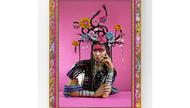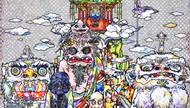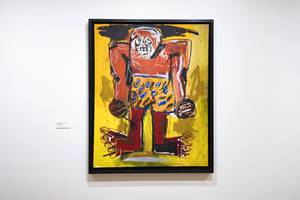
Material Existence: Japanese Art From Jomon Period to Present Through April 26; daily, 10 a.m.-7 p.m.; $15. Bellagio Gallery of Fine Art, 702-693-7871.
The Bellagio Gallery of Fine Art's Material Existence show, curated by Alison Bradley, is the first half of a two-part exhibition bringing to Las Vegas art rarely seen outside Japan. Despite the ambitious time frame—from antique to contemporary—few works are on view. Two small archeological artifacts, two contemporary sculptures, an installation and a handful of mostly recent ceramics are surrounded by empty walls and vacant floors. The spare, purified space is designed to give viewers an experience of Japanese culture by intensely focusing on a limited array of choice objects.
Westerners call the show's uncluttered aesthetic "Minimalism." In Japan, it's less an artistic or decorative style than a dimension of daily life steeped in spiritual beliefs. The vestibule, for example, features three restrained floral arrangements in understated ceramic vessels—both flowers and ceramics link to venerable craft traditions as well as Shinto and Buddhist conceptions of nature. More pots and ikebana (the Japanese art of arranging flowers) follow in the first room.
Then Tatsuo Kawaguchi's "Stone and Light" ruptures contemplative craft vibes with a vibrant work recalling Star Wars on one hand and the sword Excalibur on the other. In his mighty floor sculpture, Kawaguchi "pierces" a hunk of granite with a florescent tube-cum-lightsaber. While the contrasting materials are noteworthy—natural stone/artificial light—irrepressible metaphorical interpretations veer into physics. The tube seems to reveal the hidden energy of the stone, as if illustrating the equivalence of matter and energy. The memory of Hiroshima and Nagasaki isn't far behind.
Tadaaki Kuwayama's "Untitled," too, stands in stark contrast to Japanese crafts. With its 40 Bakelite wall panels, the installation immerses viewers in a futuristic row of vertical metallic bars—2001: A Space Odyssey's HAL 9000 on steroids. Then the precision sinks in. The subtly alternating colors—and the 7-inch-wide panels alternating with exactly 7 inches of wall in between—create a positive/negative rhythm in harmony with the lighting, architecture and planked floor. With its potential for infinite replication, the work escapes the presumed monotony of its industrial origins and attains a larger-than-life presence, its geometric purity seemingly a vehicle of truth.
The third contemporary artwork, Kohei Nawa's golden "Throne," allegorizes artificial intelligence takeover in a fiery mash-up of ancient/modern, organic/mechanical, spiritual /secular, spike/bubble, petal/rake. A scale model of the over 34-foot-tall, three-ton version that temporarily hung in the Louvre pyramid, "Throne" is made of 3D-printed plastic enveloped in gold leaf. Hidden amid the gaudy profusion of protuberances is a tiny, vacant throne symbolizing the moment of singularity when super-intelligence supersedes humanity. The sculpture functions as a cautionary tale, its mesmerizing form mirroring mesmerizing AI.
An impressive, thought-provoking show, Material Existence triumphs—despite limited artworks, questionable thematic frame and a struggle to equate decorative crafts with fine art. We're lucky to have it here.






